coolant level CHEVROLET S10 1994 2.G Owners Manual
[x] Cancel search | Manufacturer: CHEVROLET, Model Year: 1994, Model line: S10, Model: CHEVROLET S10 1994 2.GPages: 340, PDF Size: 18.45 MB
Page 196 of 340
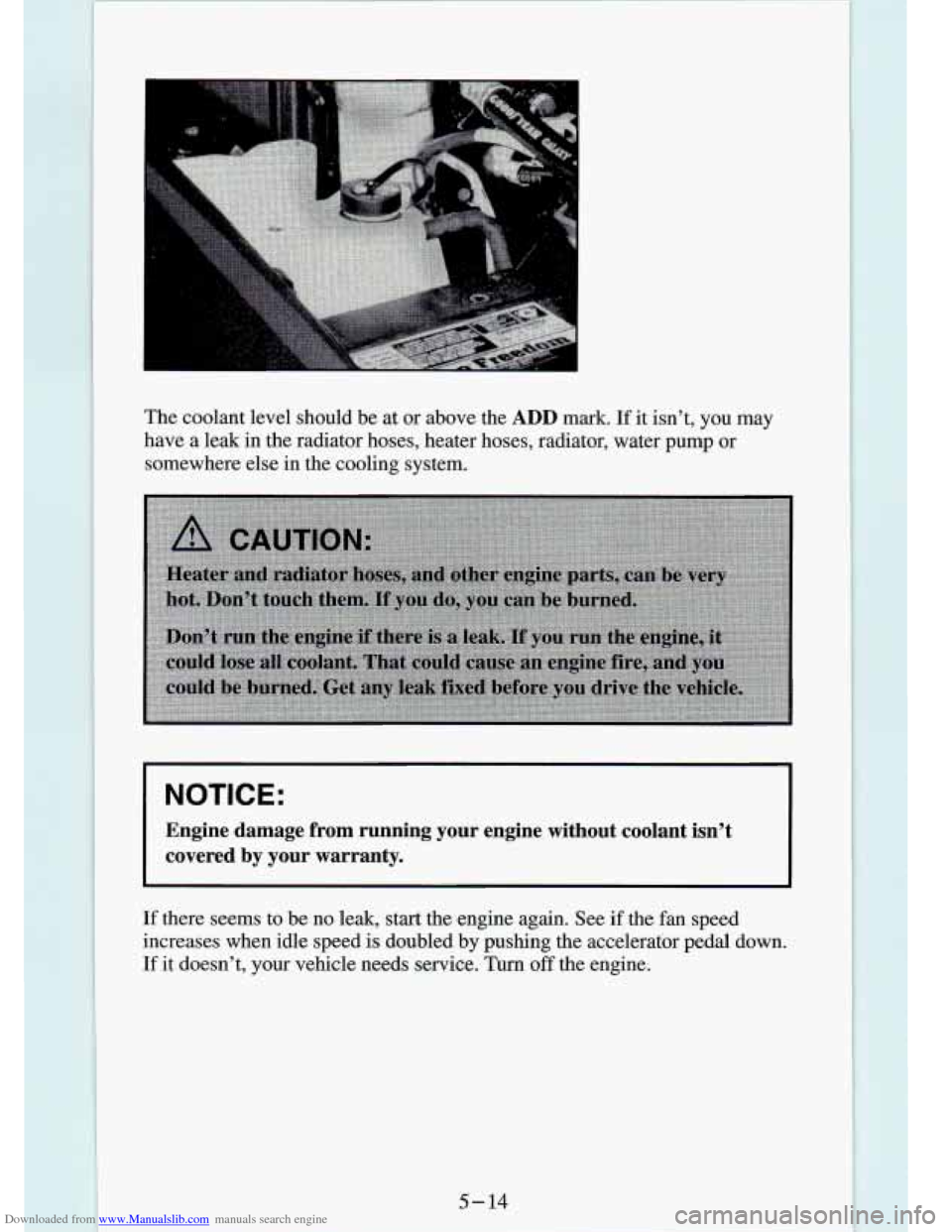
Downloaded from www.Manualslib.com manuals search engine The coolant level should be at or above the ADD mark. If it isn’t, you may
have a leak in the radiator hoses, heater hoses, radiator, wat\
er pump or
somewhere else in the cooling system.
I NOTICE:
Engine damage from running your engine without coolant isn’t \
covered
by your warranty.
If there seems to be no leak, start the engine again. See if the fan speed
increases when idle speed is doubled by pushing the accelerator\
pedal down.
If it doesn’t, your vehicle needs service. Turn off the engine.
Page 197 of 340
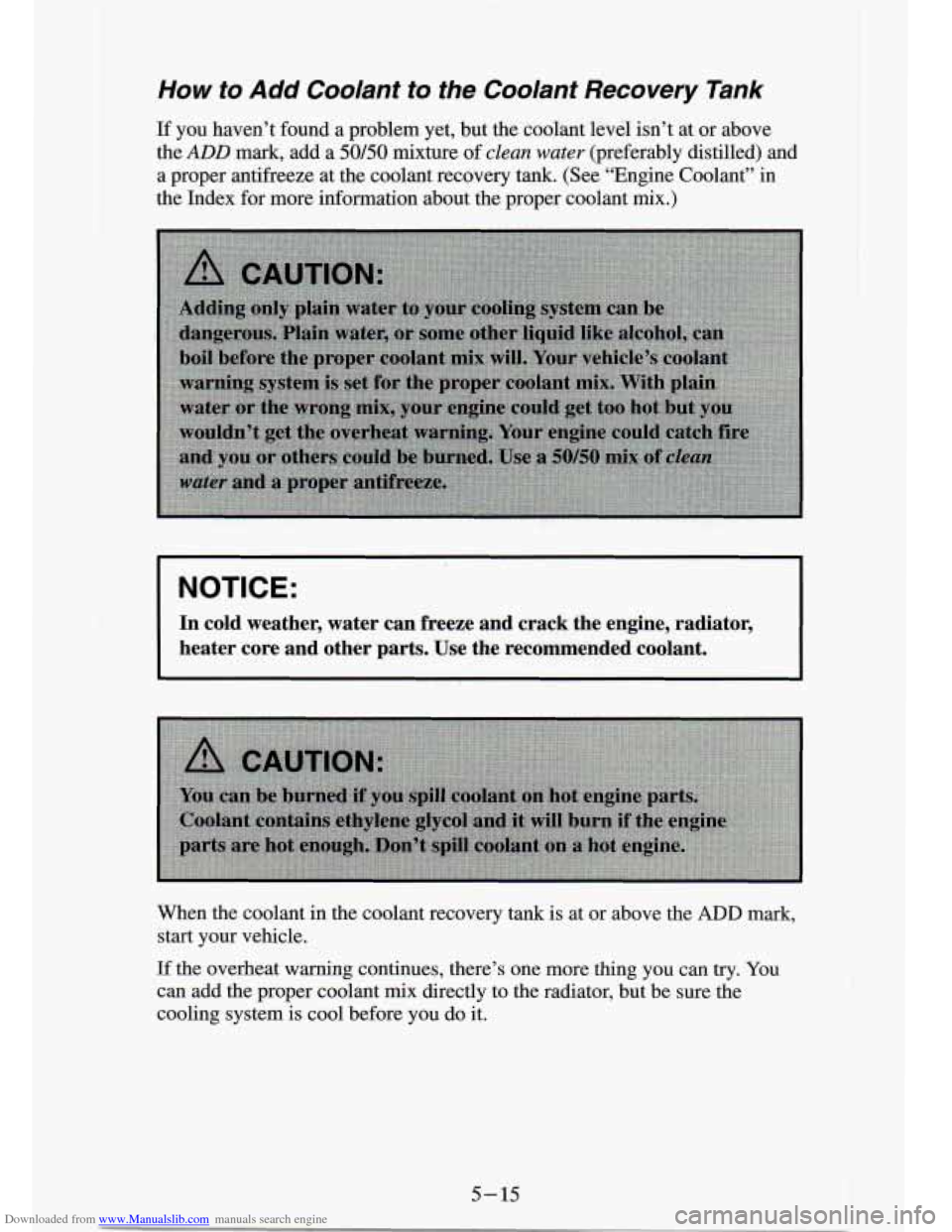
Downloaded from www.Manualslib.com manuals search engine How to Add Coolant to the Coolant Recovery Tank
If you haven’t found a problem yet, but the coolant level isn’t at or above
the
ADD mark, add a 50/50 mixture of clean water (preferably distilled) and
a proper antifreeze at the coolant recovery tank. (See “Engine Coolant” in
the Index for more information about the proper coolant mix.)
I NOTICE:
In cold weather, water can freeqe and crack the engine, radiator, \
heater core and other parts. Use the recommended coolant.
When the coolant in the coolant recovery tank is at or above the ADD mark,
start your vehicle.
If the overheat warning continues, there’s one more thing you can t\
ry. You
can add the proper coolant mix directly
to the radiator, but be sure the
cooling system is cool before you do it.
5-15
Page 201 of 340

Downloaded from www.Manualslib.com manuals search engine 7. By this time the coolant level inside the filler neck may be lower. If the
level is lower, add more of the proper
mix through the filler neck until
the level reaches the base of the filler neck.
8. Then replace the
pressure cap.
At any time during
this
procedure if coolant begins to
flow out of the
filler neck,
reinstall the
pressure cap. Be sure the arrows
on pressure cap
line up like this.
P
' Engine Fan Noise
This vehicle has a clutched engine cooling fan. When the clutch is engaged,
the fan spins faster to provide more air
to cool the engine. In most every day
driving conditions the clutch is not engaged. This improves fuel economy
and reduces fan noise. Under heavy vehicle loading, trailer towing and/or
high outside temperatures, the fan speed increases when the clutch engages.
So you may hear an increase in fan noise. This is normal and should not be
mistaken as the transmission slipping or making extra shifts. It is merely the
cooling system functioning properly. The fan will slow down when
additional cooling is not required and the clutch disengages.
You may also hear this fan noise when you
start the engine. It will go away
as the
fan clutch disengages.
5-19
Page 219 of 340
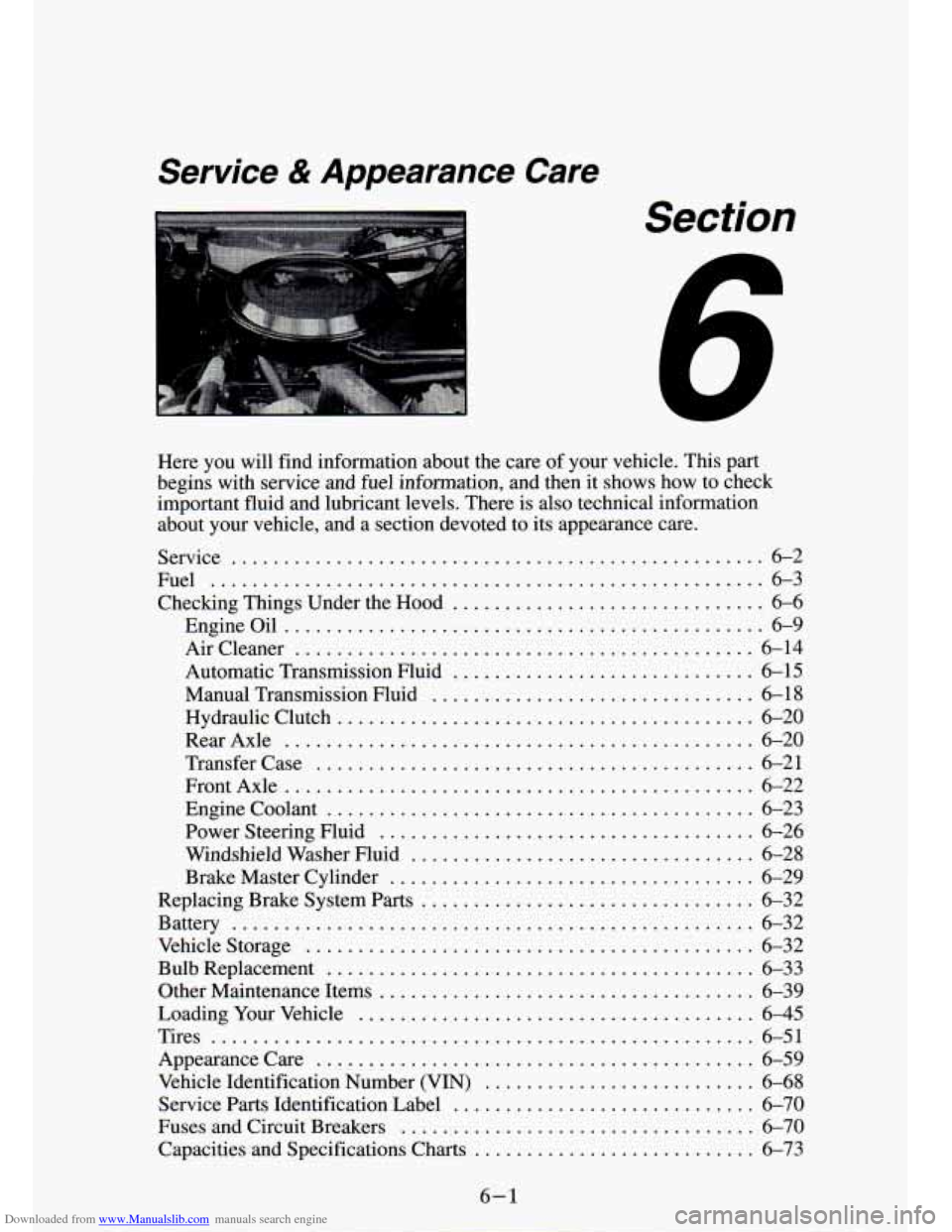
Downloaded from www.Manualslib.com manuals search engine Service & Appearance Care
I
Section
Here you will find information about the care of your vehicle . This part
begins with service and fuel information. and then it shows ho\
w to check important fluid and lubricant levels
. There is also technical information
about your vehicle. and a section devoted to its appearance care
.
Service ................................................... 6-2
Fuel
..................................................... 6-3
Engineoil
.............................................. 6-9
Aircleaner
............................................ 6-14
Automatic Transmission Fluid
............................. 6-15
Manual Transmission Fluid
............................... 6-18
Hydraulic Clutch
........................................ 6-20
RearAxle
............................................. 6-20
Transfer Case
.......................................... 6-21
FrontAxle
............................................. 6-22
Power Steering Fluid
.................................... 6-26
Windshield Washer Fluid
................................. 6-28
Checking Things Under the Hood
.............................. 6-6
Engine Coolant
......................................... 6-23
Brake Master Cylinder
................................... 6-29
Replacing Brake System Parts
................................ 6-32
Bulb Replacement
......................................... 6-33
Battery
.................................................. 6-32
Vehiclestorage
........................................... 6-32
Other Maintenance Items
.................................... 6-39
Loading Your Vehicle
...................................... 6-45
Tires
.................................................... 6-51
Appearancecare
.......................................... 6-59
Vehicle Identification Number (VIN)
.......................... 6-68
Service Parts Identification Label
............................. 6-70
Fuses and Circuit Breakers
.................................. 6-70
Capacities and Specifications Charts
........................... 6-73
6-1
Page 241 of 340
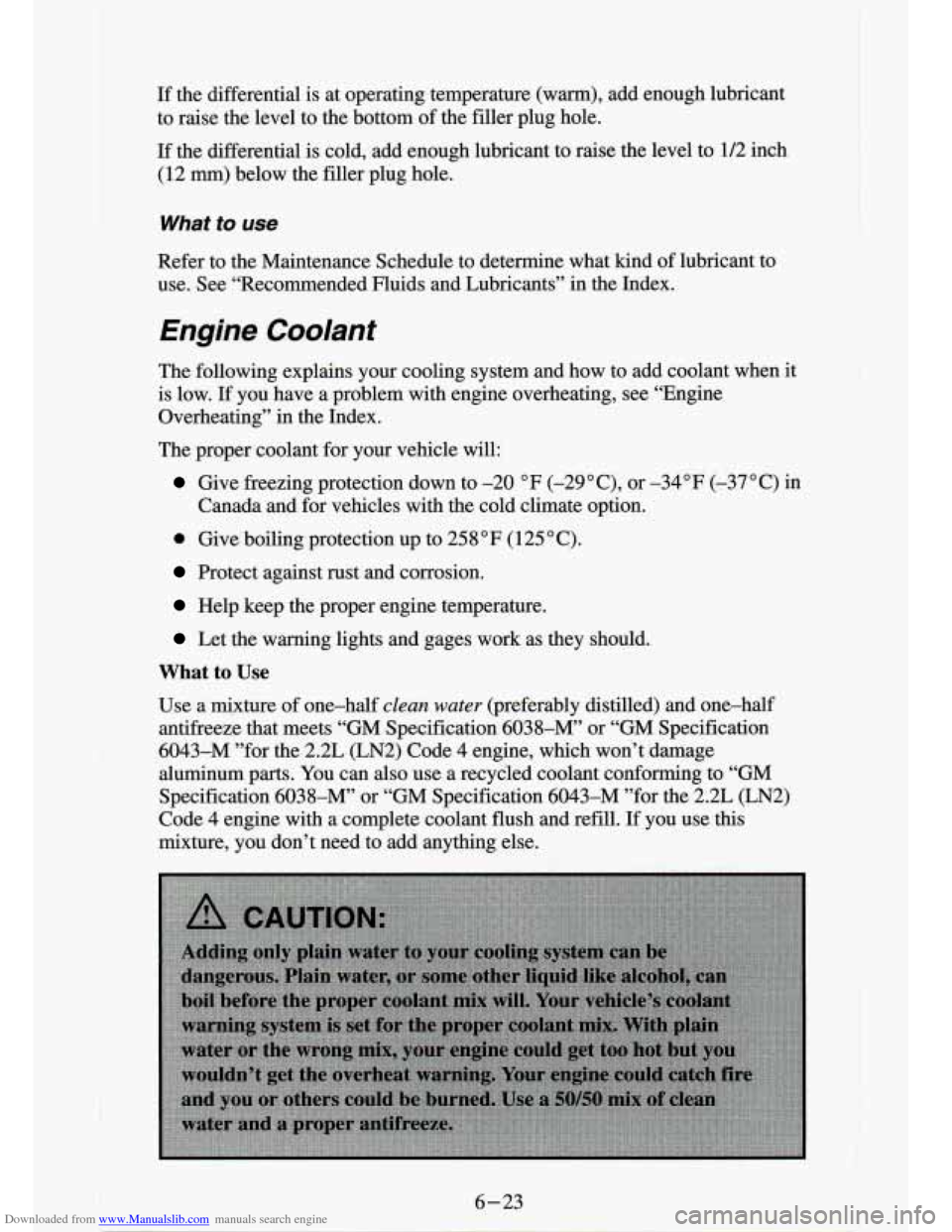
Downloaded from www.Manualslib.com manuals search engine If the differential is at operating temperature (w,arm), add enou\
gh lubricant
to raise the level to the bottom of the filler plug hole.
If the differential is cold, add enough lubricant to raise the level to 1/2 inch
(12
mm) below the filler plug hole.
What to use
Refer to the Maintenance Schedule to determine what kind of lubricant to
use. See “Recommended Fluids and Lubricants” in the Index.
Engine Coolant
The following explains your cooling system and how to add coolant \
when it
is low.
If you have a problem with engine overheating, see “Engine
Overheating” in the Index.
The proper coolant for your vehicle will:
Give freezing protection down to -20 “F (-29” C), or -34°F (-37 “C) in
Canada and for vehicles with the cold climate option.
e Give boiling protection up to 258°F (125°C).
Protect against rust and corrosion.
Help keep the proper engine temperature.
Let the warning lights and gages work as they should.
What to Use
Use a mi,xture of one-half clean water (preferably distilled) and one-half
antifreeze that meets “GM Specification 603%” or “GM Specification
6043-M ”for the 2.2L (LN2) Code 4 engine, which won’t damage
aluminum parts. You can also use
a recycled coolant conforming to “GM
Specification 603%” or “GM Specification 6043-M ”for the 2.2L (LN2)
Code 4 engine with a complete coolant flush and refill.
If you use this
mixture, you don’t need to add anything else.
6-23
Page 242 of 340
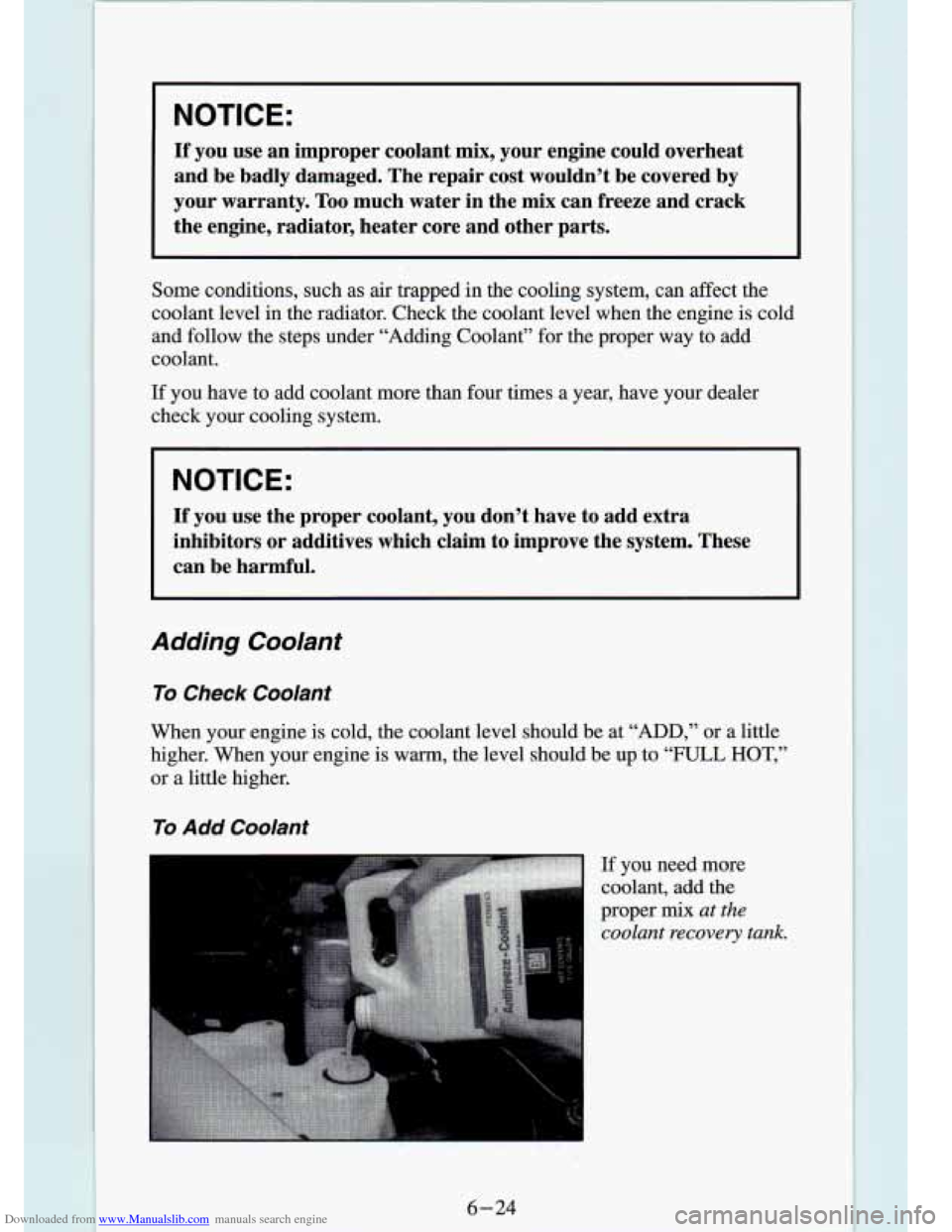
Downloaded from www.Manualslib.com manuals search engine I NOTICE:
If you use an improper coolant mix, your engine could overheat
and be badly damaged. The repair cost wouldn’t be covered by
your warranty. Too much water in the
mix can freeze and crack
the engine, radiator, heater core and other parts.
Some conditions, such as air trapped in the cooling system, ca\
n affect the
coolant level in the radiator. Check the coolant level when th\
e engine
is cold
and foilow the steps under “Adding Coolant” for the proper way to add
coolant.
If you have to add coolant more than four times a year, have your dealer
check your cooling system.
I NOTICE:
If you use the proper coolant, you don’t have to add extra
inhibitors or additives which claim to improve the system. These
can be harmful.
Adding Coolant
To Check Coolant
When your engine is cold, the coolant level should be at “ADD,” or a little
higher. When your engine is warm, the level should be up to
“FULL HOT,”
or a little higher.
To Add Coolant
I
If you need more
coolant, add the
proper
mix at the
coolant recovery tank.
6-24
Page 303 of 340
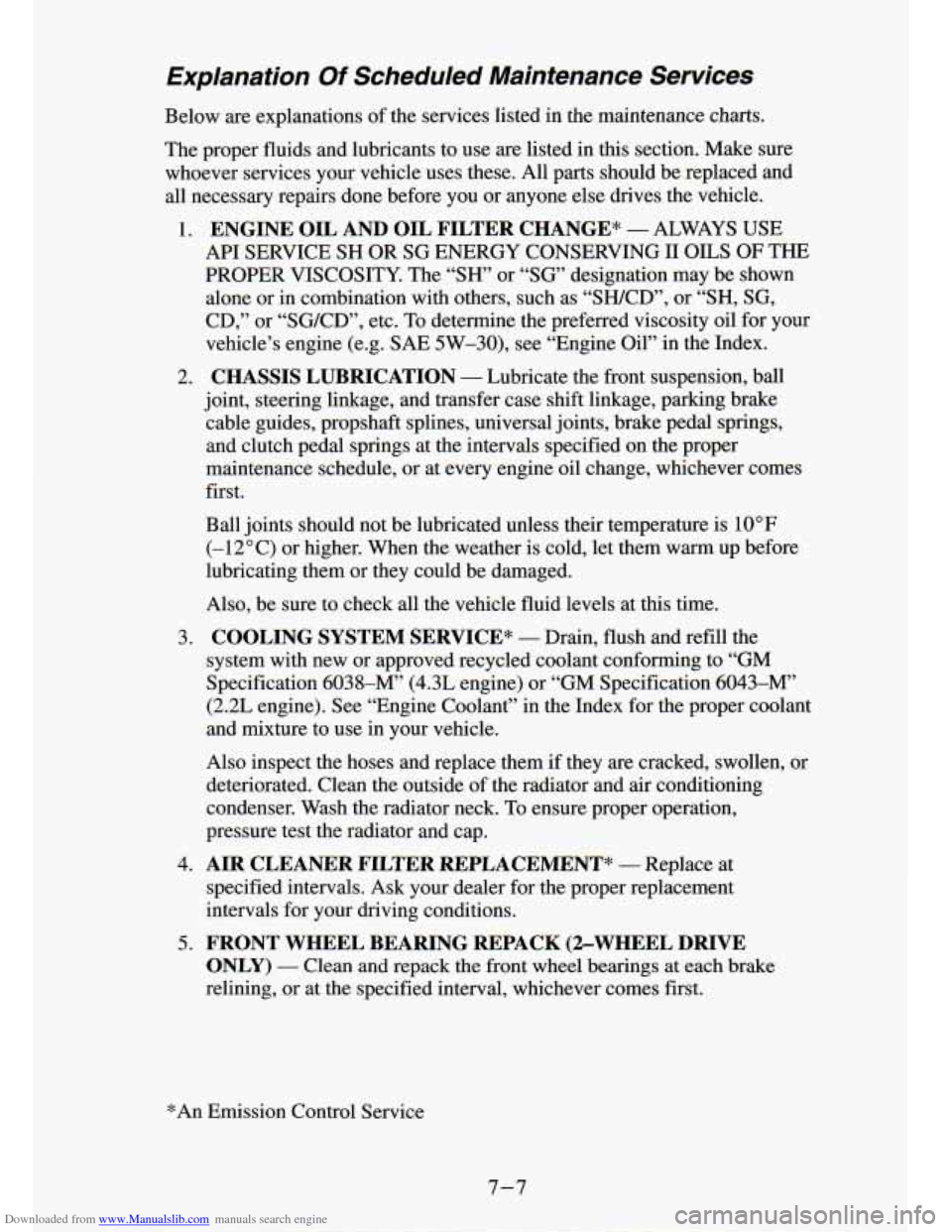
Downloaded from www.Manualslib.com manuals search engine Explanation Of Scheduled Maintenance Services
Below are explanations of the services listed in the maintenance charts.
The proper fluids and lubricants to use are listed
in this section. Make sure
whoever services your vehicle uses these. All parts should be \
replaced and
all necessary repairs done before you or anyone else drives the vehicle.
1. ENGINE OIL AND OIL FILTER CHANGE* - ALWAYS USE
API SERVICE SH OR SG ENERGY CONSERVING I1 OILS
OF THE
PROPER VISCOSITY. The “SH” or
“SG’ designation may be shown
alone or in combination with others, such as “SWCD”, or
“SH, SG,
CD,” or “SGKD”, etc. To determine the preferred viscosity oil for your
vehicle’s engine (e.g. SAE 5W-30), see “Engine
Oil” in the Index.
2. CHASSIS LUBRICATION - Lubricate the front suspension, ball
joint, steering linkage, and transfer case shift linkage, parking brake\
cable guides, propshaft splines, universal joints, brake pedal springs,
and clutch pedal springs at the intervals specified on the proper
maintenance schedule, or at every engine oil change, whichever comes
first
.
Ball joints should not be lubricated unless their temperature is 10°F
(-12°C) or higher. When the weather is cold, let them warm up before
lubricating them or they could be damaged.
Also, be sure
to check all the vehicle fluid levels at this time.
3.
COOLING SYSTEM SERVICE* - Drain, flush and refill the
system with new or approved recycled coolant conforming to “\
GM
Specification 6038-M” (4.3L engine) or “GM Specification 6043-M”
(2.2L engine). See “Engine Coolant” in the Index for the proper coolant
and mixture to use in your vehicle.
Also inspect the hoses and replace them if they are cracked, \
swollen, or
deteriorated. Clean the outside of the radiator and air conditioning
condenser. Wash the radiator neck. To ensure proper operation,
pressure test the radiator and cap.
4. AIR CLEANER FILTER REPLACEMENT* - Replace at
specified intervals. Ask your dealer for the proper replacement
intervals for your driving conditions.
5. FRONT WHEEL BEARING REPACK (%WHEEL DRIVE
ONLY) - Clean and repack the front wheel bearings at each brake
relining, or at the specified interval, whichever comes first.
*An Emission Control Service
7-7
Page 312 of 340

Downloaded from www.Manualslib.com manuals search engine Service Station Checks
It is important for you or a service station attendant to perform these
under-hood checks at each fuel fill.
@ Check the engine oil level and add if necessary.
Check the engine coolant level and add if necessary.
0 Check the windshield washer fluid level and add if necessary.
See the Index under these items for information on how to check them.